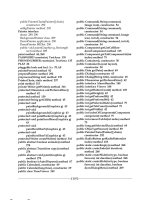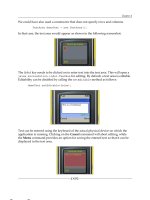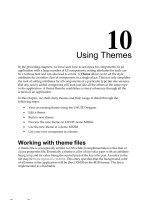Pro Java ME Apps pot
Bạn đang xem bản rút gọn của tài liệu. Xem và tải ngay bản đầy đủ của tài liệu tại đây (3.89 MB, 355 trang )
www.it-ebooks.info
i
Pro Java ME Apps
■ ■ ■
Ovidiu Iliescu
www.it-ebooks.info
Pro Java ME Apps
Copyright © 2011 by Ovidiu Iliescu
All rights reserved. No part of this work may be reproduced or transmitted in any form or by any
means, electronic or mechanical, including photocopying, recording, or by any information
storage or retrieval system, without the prior written permission of the copyright owner and the
publisher.
ISBN-13 (pbk): 978-1-4302- 3327-5
ISBN-13 (electronic): 978-1-4302- 3328-2
Trademarked names, logos, and images may appear in this book. Rather than use a trademark
symbol with every occurrence of a trademarked name, logo, or image we use the names, logos,
and images only in an editorial fashion and to the benefit of the trademark owner, with no
intention of infringement of the trademark.
The use in this publication of trade names, trademarks, service marks, and similar terms, even if
they are not identified as such, is not to be taken as an expression of opinion as to whether or not
they are subject to proprietary rights.
President and Publisher: Paul Manning
Lead Editor: Steve Anglin
Development Editor: Douglas Pundick
Technical Reviewer: Carol Hamer
Editorial Board:
Steve Anglin, Mark Beckner, Ewan Buckingham, Gary Cornell, Jonathan
Gennick, Jonathan Hassell, Michelle Lowman, James Markham, Matthew Moodie,
Jeff Olson, Jeffrey Pepper, Frank Pohlmann, Douglas Pundick, Ben Renow-Clarke,
Dominic Shakeshaft, Matt Wade, Tom Welsh
Coordinating Editor: Adam Heath
Copy Editor: Mary Ann Fugate, Sharon Wilkey
Compositor: MacPS, LLC
Indexer: SPi Global
Artist: SPi Gobal
Cover Designer: Anna Ishchenko
Distributed to the book trade worldwide by Springer Science+Business Media, LLC., 233 Spring
Street, 6th Floor, New York, NY 10013. Phone 1-800-SPRINGER, fax (201) 348-4505, e-mail
, or visit www.springeronline.com.
For information on translations, please e-mail , or visit www.apress.com.
Apress and friends of ED books may be purchased in bulk for academic, corporate, or
promotional use. eBook versions and licenses are also available for most titles. For more
information, reference our Special Bulk Sales–eBook Licensing web page at
www.apress.com/bulk-sales.
The information in this book is distributed on an “as is” basis, without warranty. Although every
precaution has been taken in the preparation of this work, neither the author(s) nor Apress shall
have any liability to any person or entity with respect to any loss or damage caused or alleged to
be caused directly or indirectly by the information contained in this work.
The source code for this book is available to readers at www.apress.com. You will need to answer
questions pertaining to this book in order to successfully download the code.
www.it-ebooks.info
Mom, Dad, Grandpa – Thank you for everything. I love you.
www.it-ebooks.info
iv
Contents at a Glance
Contents v
About the Author xi
About the Technical Reviewer xii
Acknowledgments xiii
Introduction xiv
■
Chapter 1: Getting Started 1
■
Chapter 2: A Java ME Framework 25
■
Chapter 3: Defining Our Data 51
■
Chapter 4: The Networking Module 63
■
Chapter 5: The Persistence Module 93
■
Chapter 6: The UI Module 115
■
Chapter 7: The Localization Module 155
■
Chapter 8: Putting It All Together 169
■
Chapter 9: Device Fragmentation 193
■
Chapter 10: Optimizing Your Code 223
■
Chapter 11: Adding Fine Touches and User Interaction Improvements 251
■
Chapter 12: Java ME Application Testing 271
■
Chapter 13: Advanced Java ME Graphics 283
■
Chapter 14: The Proper Java ME Mindset 305
■
Chapter 15: Java ME and the Future 325
■
Chapter 16: Final Words 337
Index 341
www.it-ebooks.info
v
Contents
Contents at a Glance iv
About the Author xi
About the Technical Reviewer xii
Acknowledgments xiii
Introduction xiv
■
Chapter 1: Getting Started 1
Java ME, Smartphones, and Feature Phones 1
Java ME’s Advantages 1
Java ME’s Disadvantages 2
The Bottom Line 3
Creating a Java ME Application 3
The Idea for the Application 4
Goals, Features, Revenue Sources, and Target Devices 4
Identifying the Target Devices 6
Identifying Java ME Technical Limitations 7
Regular Java ME Applications vs. Pro Java ME Applications 13
Writing Flexible Java ME Applications 15
Coding Defensively 16
Avoiding Wrong Assumptions 18
Learning How to Handle Complexity 18
Trade-Offs Are Your Friends—Use Them Wisely 20
Aim for a Loose and Decentralized Architecture 22
Never Do On-Device What You Can Do Off-Device 23
Summary 24
■
Chapter 2: A Java ME Framework 25
The Importance of Using a Framework 25
Why a Custom Framework for Each Application? 26
Defining the Framework’s Structure 27
Basic Object Types 28
Events 29
Event Listeners 31
www.it-ebooks.info
■ CONTENTS
vi
Providers 31
Consumers 32
Managers 33
Models and Controllers 33
Views 34
Common Objects 35
The EventController Class 35
The EventControllerManager 37
Core Objects and Classes 39
The Application Class 39
The EventManagerThreads Class 40
The Bootstrap Class 44
A Simple Test Application 45
Summary 49
■
Chapter 3: Defining Our Data 51
Why Implement the Model Interface? 51
Making Data Types Immutable 52
Defining the Tweet Data Type 53
Defining the TwitterUser Data Type 54
Defining the TwitterServer Entity 55
Defining the UserCredentials Data Type 56
Defining the TweetFilter Data Type 58
Defining the Timeline Entity 58
Choosing Intelligent Representations for Your Data 59
Summary 61
■
Chapter 4: The Networking Module 63
Setting Up and Configuring the Library 63
Working with High-Level Objects 66
Using Your Own Data Types 66
Writing Our TwitterServer Implementation 67
Defining the General Structure 67
Initializing a ServerImplementation Instance 68
Providing Login Support 69
Posting Tweets 73
Retrieving Tweets 74
The getMyProfile() and getProfileFor() Methods 85
Best Practices for Java ME Networking 86
Do Not Reinvent the Wheel 86
Mobile Internet Is Special 87
Remember the Limitations of the Devices You’re Targeting 88
Support Network Throttling and Sleep Mode 88
Transmitting Your Data Efficiently 89
Keeping the Networking Code Light 90
Be Independent 91
Summary 91
www.it-ebooks.info
■ CONTENTS
vii
■
Chapter 5: The Persistence Module 93
Understanding Java ME Persistence Options 93
Designing the Persistence Module 95
The Persistence Providers 96
RecordReaders and RecordWriters 97
Serializers and Deserializers 99
Persistence Helpers 100
Implementing the Core Architecture 100
Implementing Serializers and Deserializers 101
Implementing RecordReaders and RecordWriters 103
Implementing the PersistenceProvider 104
Testing the Code 106
Writing Persistence Helpers 107
Using the Module in a Real-Life Scenario 112
Taking the Module Further 113
Summary 113
■
Chapter 6: The UI Module 115
Why Create a Custom UI Module? 116
Understanding the Basics of Creating a UI Module 116
Widgets 117
Containers 118
Clipping Rectangles 120
Views 124
Themes 124
Handling User Interaction 126
Implementing Basic Widget Support 127
The BaseWidget Class 127
BaseContainerWidget and BaseContainerManager 130
Implementing Concrete Widgets 135
The VerticalContainer and HorizontalContainer Classes 135
The SimpleTextButton Class 139
The StringItem Class 141
InputStringItem 143
GameCanvasView 146
Testing the UI Module 147
Implementing UIs on Touch-Only Devices 149
Final Words About the UI Module 151
Summary 153
■
Chapter 7: The Localization Module 155
Understanding the Features of a Good Localization Module 155
Understanding Native Java ME Localization 156
Adding Custom Localization Support to a Java ME Application 157
Processing Localization Files 159
Loading Localization Data on the Device 161
Testing the Localization Module 164
Implementing Advanced Localization Features 165
Summary 168
www.it-ebooks.info
■ CONTENTS
viii
■
Chapter 8: Putting It All Together 169
Jump-Starting the Application 169
Implementing the FlowController 170
Implementing the TweetsController 173
Implementing the WelcomeScreenController and the WelcomeForm 175
Implementing the MainForm and MainScreenController 179
Implementing the SettingsScreenController and the SettingsForm 184
Implementing the EVT Class 188
Improving the Application 189
Improving Error Handling 189
Increasing Functionality 191
Improving the UI Framework 191
Summary 192
■
Chapter 9: Device Fragmentation 193
Hardware Fragmentation 194
CPU Power 194
RAM 197
Screen 199
Other Hardware Considerations 201
Capabilities Fragmentation 202
API Inconsistencies 206
Localized API Inconsistencies 207
Global API Inconsistencies 210
Inconsistencies Open for Interpretation 212
Porting Frameworks 214
The Preprocessor 214
The Device Database 216
The Build Engine 216
The Abstraction API 217
Multi-platform Support 218
Utility Code and Tools 218
UI Library 219
Customer Support 219
Code License 220
Cross-Development and Porting Tools 220
Summary 221
■
Chapter 10: Optimizing Your Code 223
A Crash Course in Optimizing Code 224
Code Optimization Techniques 226
Fast Code Path Switching 226
Avoid Redundancy 227
Use Locality to Your Advantage 227
Optimize Your Math 228
Unroll Loops 231
Inline Code 231
Optimize Loop-Related Math 232
Keep Your Loops Conditional-Free 233
www.it-ebooks.info
■ CONTENTS
ix
Eliminate Special Iterations from Your Loops 234
Use Loop Fission 235
Avoiding High-Level Language Features 235
Stick to the Basics 236
Avoid Unnecessary Object Creation 237
Optimize Memory Access 240
Algorithm Optimization Techniques 241
Comparing Algorithms 241
Improving Your Algorithms 243
Summary 250
■
Chapter 11: Adding Fine Touches and User Interaction Improvements 251
Adding Fine Touches to Your Application 251
Understanding Fine Touches 252
Adding Proper In-Application Help 253
Adding Contextual Information 255
Adding Proper Feedback 256
Adding Adaptive Text Capabilities 257
Adding History and Auto-Complete Support 259
Adding Intent Detection 260
Synchronizing Your Data Between Devices 261
Improving User Interaction 262
Eliminating User Confusion 263
Keeping the Interface Simple 264
Allowing Customers to Reach You Easily 266
Creating Nonmobile Versions of Your Application 267
Deploying Continuous Application Updates 267
Adding Skin Support 268
Advertising Related Products 269
Deciding Which Fine Touches and Improvements to Implement 270
Summary 270
■
Chapter 12: Java ME Application Testing 271
Gathering Debug Information 271
Performing Unit Testing 273
Solving Common Unit Test–Related Problems 274
Gathering Quality Debug Data 275
Running the Tests in a Desktop Environment 276
Performing Visual Debugging 276
Performing Battery Testing 277
Testing the Application in a Variety of Scenarios 279
Testing Performance Improvement and Optimization Techniques 280
Summary 281
■
Chapter 13: Advanced Java ME Graphics 283
Using Pre-rendered Graphics 284
Using Image Masking 287
Using Image Blending Techniques 289
Rotating Images 294
Resizing Images 300
www.it-ebooks.info
■ CONTENTS
x
Implementing Other Graphical Effects 301
Combining Multiple Effects Together 302
Summary 303
■
Chapter 14: The Proper Java ME Mindset 305
Java ME Is Only As Powerful As the Devices It Runs On 306
Best Practices for Optimizing Your Application 309
Sticking to Your Priorities 311
Thinking Outside the Box Is Important 314
Keeping Things Simple 315
Standardizing the User Experience 317
Planning for the Worst-Case Scenario 320
Determining Your Application’s Limits 320
Summary 323
■
Chapter 15: Java ME and the Future 325
Java ME Hardware Evolution 325
The Evolution of the Java ME API 327
The Evolution of the Java ME Mindset and Development Philosophy 328
Java ME’s Target Market 329
Java ME and Other Platforms 330
Java ME Application Types 331
Java ME Innovation 332
Java ME’s Death 333
Summary 335
■
Chapter 16: Final Words 337
What we have covered in the book 337
What to research next 338
In closing 339
Index 341
www.it-ebooks.info
xi
About the Author
Ovidiu Iliescu is a self-taught software developer; he started to write computer programs when
he was 9 and now has almost 15 years of experience under his belt. After writing desktop
applications and web-based applications, Ovidiu shifted his attention to the field of mobile
development. With a passion for all things computer related, his main interests besides mobile
software are computer graphics, algorithms and optimizations.
Ovidiu lives in Romania and has recently started his own software company, November
Solutions, to turn his ideas into products – and maybe conquer the world. Currently, he is also
working as a software developer for Enough Software and occasionally takes on interesting
projects as a freelancer.
You can get in touch with Ovidiu by visiting his website at www.ovidiuiliescu.com .
www.it-ebooks.info
xii
About the Technical
Reviewer
Carol Hamer received her Ph.D. in Number Theory from Rutgers, the State University of New
Jersey. Since then, she has worked as a software engineer for twelve years in the U.S., France, and
Switzerland, including three years working for In-Fusio Mobile Games.
Carol has written three books on mobile game programming: J2ME Games with MIDP2,
Creating Mobile Games, and Learn BlackBerry Games Development, all from Apress.
www.it-ebooks.info
xiii
Acknowledgments
Douglas Pundick and Carol Hamer have provided valuable help and suggestions for the book’s
content. Adam Heath has kept an watchful eye on things and has extended my deadlines more
than once. Mary Ann Fugate and Sharon Wilkey have painstakingly copy edited the entire
manuscript. Without them, this book could not exist. Thank you!
My friends and loved ones have been very supportive of me during the entire writing process.
They have tolerated my busy schedule and my sometimes weary attitude. For this they have my
gratitude.
Special thanks go out to Robert Virkus and to everyone at Enough Software for their support
and for being an exceptionally awesome bunch of people.
Finally, a lot of people not mentioned here worked behind the scenes at Apress and at other
companies to bring this book to light. Thank you!
www.it-ebooks.info
xiv
Introduction
I find mobile phones to be amazing pieces of technology. They allow you to be almost anywhere
in the world and still be able to reach your friends, loved ones, colleagues or business partners
with a press of a button. If that wasn’t enough, they have grown so powerful that they are now
nothing short of pocket computers. Only a few decades ago the only place you could see a similar
devices was a Star Trek movie – now they’re reality.
Modern mobile phones run on a variety of software platforms, but by far the most popular
one in terms of reach and market share is Java ME. This once feature-limited platform has grown
and matured over the years along with the hardware supporting it; is now capable of delivering
truly amazing applications that have the potential to reach hundreds of millions (if not billions)
of people.
It is a bit disappointing, then, that the techniques developers use to write Java ME
applications have not kept up with the times. Many developers, especially less experienced ones,
tend to approach Java ME development in the same extremely conservative way that it was
approached almost a decade ago, when the platform was in its infancy. Or, even worse, they treat
Java ME like a desktop platform, with complete disregard to its nuances and to the fact that it is,
in fact, a mobile platform designed to run on mobile devices. As a consequence, many Java ME
applications fall short of their potential.
The book you are reading right now aims to correct this by presenting how modern Java ME
application development should be approached – complete with all the important tips and
techniques applicable to the platform today.
What is covered in this book
This book is somewhat different from other Java ME books, in that it is built around writing a
complete and fully-functional Java ME application from scratch, using modern day development
techniques. To this end, everything from writing an application framework to writing a UI
module (complete with widgets and touch support) will be discussed – no important application
component will be left uncovered.
Furthermore, you will get to see how all of these fit into the context of a real-world
application and how individual application components interact and work together. Decisions
made along the way will be explained, potential pitfalls will be highlighted and important advice
stemming from hands-on experience will be given - all in an effort to create a comprehensive
picture of what modern Java ME application development is all about.
Once the application is written, we will cover other aspects essential to Java ME
development. Code optimization, application testing, advanced graphics, improving the user’s
experience and the proper Java ME developer’s mindset will all be discussed.
Finally, we will take a look at Java ME’s future in order to get a better understanding of where
the platform is heading and a list of further research topics relevant to Java ME development will
be given.
www.it-ebooks.info
■ INTRODUCTIN
xv
What you will need for this book
First of all, you should be familiar with Java ME development on at least an intermediate level.
This is not a beginner’s book – in fact, it is assumed that you have worked on at least one
medium-sized Java ME application before.
Second, the target device for the source code presented in this book is the WTK emulator. For
best results, it is recommended that you have both versions 2.5.2 and 3.0 installed. The WTK
emulator has been chosen because of its ubiquitous nature and because it is pretty much the
“reference implementation” for Java ME. However, the code is designed to be as portable as
possible; running it on other emulators and on real devices should work just fine (but cannot be
guaranteed).
It is also recommended that you run all the code presented and experiment with it. Java ME
is all about subtleties, many of which have to be seen in action in order to be grasped. For
obvious reasons, this is not possible with static code listings.
Let the fun begin
Java ME development, for me, is always a fun endeavor. While not always easy, it is almost never
dull either; there’s always some new challenge to overcome and something new to learn from
overcoming it.
With this in mind, I hope that you will enjoy reading this book and that the information
contained within will help make your life as a Java ME developer easier, more fun and more
interesting.
www.it-ebooks.info









